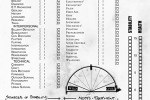Oathbound
Oathbound is a setting for Pathfinder Roleplaying Game and published by Epidemic Books.
By Greg Dent
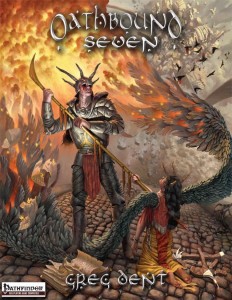
Welcome to the twenty-first Designer’s Diary, a regular column where designers are given the opportunity to take readers on an in-depth ride through the design and development process of their system, setting, or product. If you’d like to share your product in the Designer’s Diary column, send a message to aaron@roleplayerschronicle.com.
Designer’s Description
Oathbound is a rogue world that touches upon all other planes and draws in the best and the wildest from each, forcing it all into conflict in order to create the ultimate hero. Yet it is also a real word in and of itself. It is older than most other realms, and has its own cultures, races, and mythology. Bluntly, Oathbound is the campaign setting that takes place on the planet known as the Forge, so named because it forges heroes out of those it draws there. Oathbound is a great trap, yet also a rich reward. At the center of the world lies a great mystery, and seven of the most powerful creatures in all of creation are set as eternal guardians, bolstered by the great Oath, woven by a thousand gods to keep the mystery forever sealed. The Oath says that one of the Seven may go free only if it can find someone greater than it to take its place. To this end, the Seven seek out “seeds” (aka, fresh blood) of great potential throughout the multiverse and bring them to the Forge to be tested and pushed to their fullest potential.
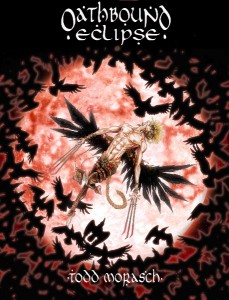
The main thread of the Oathbound story has evolved over the years, weaving its own narrative and making an interesting read even outside of the gaming universe. We weren’t content to simply make the Forge a hodgepodge of outside ideas, it had to have its own feel and its own flavor. We gave the setting its own vernacular, and the core books have a glossary at the end defining the unique language. The Forge itself is split into seven distinct and very different regions, each reflecting the personality of its guardian. Each one is essentially a different environment and a different campaign setting (being basically a continent). Our goal is to document the entire planet. We started with Penance at the center of the world (an environment made up entirely of city) and then expanded to the savannah around the city. From there we went to the vast red battle desert of Arena and the harsh wilderness of Wildwood. Most recently, we have documented the eternal night of Eclipse at the top of the world (our best book, frankly), and next up would be Anvil, the rugged mountain wilderness on the far side of the planet. In the future, we have yet to tackle the undead winter of the Vault and the volcanic madness of the Kiln.
One thing we try to do with Oathbound is constantly push the envelope of game design. Each book we write does something new or different. In the original book we introduced the concept of the “prestige race” which now have evolved into “evolutions”. The magic of the Forge cuts those who enter it off from outside worlds and outside gods, but the planet itself radiates a constant supply of raw creative energy that those who know how to use it can channel into themselves or the world around them. With evolutions, one can use the magic to alter one’s own DNA, allowing oneself to grow faster or stronger, grow wings, scales, gills, spider legs, or whatever one can conceive of. Our second book worked this channeling into its own magic system, and subsequent products have each added their own unique element to the game.
Our current focus is on presenting the most immersive world possible. We’ve tried to strip away some of the language and conventions that separate the game world from the reader and present the books as if they might exist in the world themselves. They are written by a distinct personality from the game world, and try as best as possible to keep the subject matter relevant to the writer and the world itself.
Purpose
Todd Morasch and I started Bastion Press in 2001 with Jim Butler, and from the start we wanted to create our own unique brand. A campaign setting seemed the best way to start, so we spent several weeks debating where to go from there. Todd and I mostly did all the creative work and Jim gave approval or disapproval of our ideas. At the beginning, Jim tied our hands somewhat with what seemed like Byzantine and arbitrary rules of what a campaign setting needed to have. Anything straightforward would never have appealed to Todd or I, and anything too “out there” wouldn’t pass Jim’s rules, so ironically, we ended up developing a setting centered around the powers that be having to navigate around a long series of Byzantine and arbitrary rules to create a world.
One of the first things we decided when developing Oathbound was that we wanted it to be a high-level setting, and that we’d leverage our fan base by letting them take their beloved characters that had outgrown whatever world they currently lived in and use them somewhere new. That inspired the idea of the pull—the act of the Seven stealing things and people from other worlds. That was mostly Jim’s influence. Todd and I just wanted to do something non-generic, meaning basically a setting that didn’t look just like every other fantasy setting out there, which for the most part means Tolkien-based in feel. My idea for this was to have the setting be inspired more by Greek and Roman mythology than medieval chivalry. Todd wanted to take away the human-centric nature of the world, and we added a wide variety (literally dozens) of completely new PC races to populate the world. Many of these are not just non-human, but non-humanoid, like the ceptu, the amphibious telekinetic magical jellyfish, or the dolphin, which is just a dolphin… though possibly outfitted with robotic arms and a voicebox and hover magic. Most of our races though are more animal based, like the catlike frey or the canine dover, the most populous race on the Forge. In our recent reboot of the series (Oathbound Seven), there are fifteen player character races statted out.
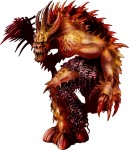
Finally, Todd and I kind of snuck this one in past Jim, but we wanted our world to be more gritty and realistic than other similar settings, so we pretty much did away with the concept of alignment. The excuse was that the Oath blocks alignment from being detected so that nobody would ever unlock the great mystery as they’d never know whether it would be on their side or not. The reality is that alignment takes real morality out of the game and reduces it to its most cartoonish level. Alignment doesn’t exist in the real world, so why would it exist in any realistic game world either? What’s the point of role-playing if you can’t experiment with a different set of rules or ways of thought to society? Players can’t just rely upon the “It’s evil, kill it!” mentality, they have to engage in the world, use their judgment, and make the best decision they can, even if it isn’t perfect. Reality means having to give up good for good enough.
Even in our most recent product, the new Bestiary for Oathbound, I ran into this. I took the monsters from the designers, sent them to the editors and figured they were probably done. As prep for layout I took out the alignment line from them all, and then upon reading a number of them I was struck by the thought, “Why is this a monster?” Once they didn’t say “Evil” on them, there was nothing to indicate their motivation or why they might come into conflict with others. With each of these I ended up having to come up with a better concept, or at least expand upon the existing writeup until I was satisfied I was dealing with a true foe.
Influences
Well, Oathbound was conceived in 2002, and our favorite setting at the time was undoubtedly Planescape. There is definitely quite a bit of Planescape in the melting-pot style world and something of the Lady of Pain in the figure of Israfel, the original mistress of Penance. We also borrowed something from Ravenloft in the stealing people from other worlds thing. Also, Dark Sun provided some influence, particularly over the domain of Arena, as far as having a gritty feel and consisting of a hot, war-torn, endless desert landscape.
Beyond this, my own influences came from my education steeped in Greek mythology, and in my own personal hobby of seeking out and reading the myths of other cultures. Probably the biggest influence though was Todd’s own home games that we have been playing for several years before writing Oathbound. Most of the new races and creatures came from these settings, and much of the Forge’s distinctive mythology came from Todd’s unique vision of the universe.
Research
Well, my designer’s “bible” for Oathbound is a pretty beat-up old copy of Bulfinch’s Mythology. A lot of the names and language used in Oathbound come from there, typically morphed or in some way. I think this contributes significantly to the feel that Oathbound is both a real world and a non-generic one. The names feel real because they are. You have to be grounded in something, especially if you want go on the highest flights of fancy.
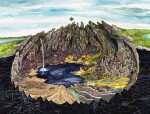
Beyond this though, I have done a wide variety of research here and there as warranted by what we are writing. The first research I probably did back in 2002 was all astronomical. Since we were going to do an entire planet, I wanted to keep it small, so we decided the Forge would be about the size of Earth’s moon… but how big is that exactly? We also have two suns and two moons in the sky on the Forge, and I spent a great deal of time figuring out how that would work. From here we ended up with a completely different set of seasons than on Earth (and all other Earth-based campaigns). The Forge has its own way of tracking time and its own calendar and holidays. Actually in Eclipse, since there is no sun, we discovered as we were writing it that there is no natural way to track time there (at least in small scale). We could have invented timepieces for everyone there, but that would be boring, so we went the other direction. We invented an entirely new idea of society that didn’t require time. Most recently, we really had to study topology in order to come up with an actual globe model of our world map that we released for Oathbound Seven. That was a real mind bender.
I did a lot of population research as well. I based the density of the city of Penance on Monaco here on Earth, for example. I had to research boat travel—how long does it take to get around on various types of ships? How long would it take you to hit bottom if you jumped off the cliffs above Eclipse… 300 miles above Eclipse that is. And how long would it take to fly up, or to climb up.
One other thing I like to do with Oathbound is experiment with different ways a society can function. Since the Forge can pull people in from anywhere, there’s a real freedom to mix and match ideas there. For Eclipse, Todd and I came up with two completely different socio-economic models. His Stygia is a city-state run entirely by vampires, and the economy there is very much slave-oriented and based on generations of power building and machinations. My Baradume is a city of thieves. In 2002 when we did the overview of the Forge, that sounded good enough, but when we did Eclipse we had to sit down and think, “Well what does that mean?” Inspired somewhat by Burning Man, I came up with a society without money at all, where people work for guilds (or more like big mob families) that provide them with everything they need (food, shelter, drink, entertainment) in return for their labors. Beyond the necessary, people take whatever they want and good thievery is considered an art. Outside the city, the guilds deal with money and markets and all that, but within the city, all is free and open. It took about a week to get all the checks and balances worked out, but I’m actually really happy with how it worked out, and wouldn’t mind living there myself someday.
Our first book had a few editing flaws, and the most grievous was that Jim reordered the chapter of city-states within the City of Penance alphabetically. I considered this chapter my big masterpiece, as there were something like nine or ten fully functioning societies described there all with completely different social and economic models. Barrowhold was an ancient place where the complex 20-level caste system meant everything. Utopia was a dystopian view of somewhere America might have been headed, a prison state where the rich ruled and everyone else sat in jail and was forced to manufacture cheap goods all day long. Todd’s Illumina was an experiment in controlled lawlessness, and my Oasis was meant to be Plato’s ideal of a golden-hearted ruler running the state for the benefit of all. Only stuck in between all the other awful places so he had to make some pretty hard choices to survive. In the updated Oathbound story in Oathbound Seven, Flollo has changed significantly—a bit of a broken man (well, lizard really) still trying to do his best even though he knows it is all probably futile and there is no future in it for him.
The problem with reordering this chapter, is that one of the city-states was called “the Alliance” which starting with “A” now came at the beginning. So pretty much everyone who got the book read the first page and thought, “Oh, some alliance of lords runs Penance.” and failed to understand the many faceted and complex web of powers we had set up to function as the Penance setting. I even remember reading a review in 2003 that said, “Oh and Chapter 7 outlines the alliance of lords that runs the city. And chapter 8…” This won’t happen with the new Oathbound.
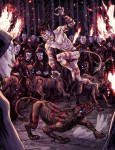
Art Direction
This has historically been Todd’s baby, though for Eclipse I ended up taking on the Art Director role since he was doing the bulk of the writing. There’s more to it than I thought. The entire Eclipse book is dark—we actually went to an art store and bought several dozen different kinds of paper and digitally scanned it all to give an ashen texture to the printed pages. The art had to be unique as well; since there is no sunlight there, the people had to be pale and all the scenes had to be drawn at night. I had to reject many paintings not because the quality way bad, but because they were drawn in daylight. Most artists had never even considered drawing something at night before—without light it’s pretty hard to give clarity. We also wanted the book itself to read like art. We wrote the book like it was a scrapbook compiled by the former guardian of the land. Every chapter had at least one section that looked like someone took a few pages out of a diary or a leaflet or something and pasted them into the book. Even the drawings have little corner pieces holding them in like they were pasted right on the page. We even came up with a variety of supporting characters in the world itself who supposedly had painted the art. In the werran section there’s a big muddy paw print on one of the pages that makes it look like some big were-bear leaned in while Colopitiron was journaling and said “Hey, what’s that you’re writing in there?”
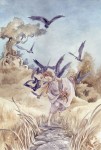
We also try to put a lot of symbolism in our Oathbound art. There are a number of iconic elements to the world that we try to show as much as possible. The great Oath holds the whole prison together, and we try to show it in the form of books and chains. The avatars of the Seven guardians all must wear a book chained to their bodies at all times that contains all the rules by which they are bound. At Gen Con 2003 Todd even sculpted these ancient books for us that we wore strapped to our belts and wrists as we ran the booth. The Seven are probably the most iconic Oathbound figures, having been born right from Todd’s unusual brain. The Seven have elements of both angel and demon together. They have four horns and feathered wings, empty eye sockets, and ornate masks that cover their faces. The Seven are also represented by their ravens, which they can use to spy on what happens throughout the land. Lots of our pictures have ravens in them, and we even bought a bunch of stuffed ravens and placed them all over our booth at Gen Con. I still have one ratty one left that sits on my desk and watches me work.
We also try to use the art to Illustrate the world itself so that it looks like an alien place. Letters are never in Latin characters if they are visible, and the architecture is a strange blend of old and new. The Forge is an old, old world, so there is plenty of room for civilizations that have mastered different kinds of technology and then fallen to ruin. There are guns and flying ships here, but we only add them as color, we don’t let them overpower the classical base of the world.
Gaming Experience
We do have an art guide for Oathbound that we wrote a while back and that I updated for Eclipse. The most memorable guideline in this says “always show three sides to every conflict.” I don’t know that we do that in the art so much, but the story reads this way.
I think the Forge is meant to be a more chaotic, fast-paced, and morally ambiguous place than the typical game world. We put a lot of mature concepts in both the art and the story, so it’s not really meant for children or first-time gamers, but for people who have been there, done that, and want to go somewhere where they have to push the limits of what they are used to.
We’ve tried to make the Forge a non-human-centric world, and not just in the way characters look, but in the way they think, act, and believe. It can be fun just to experiment with different ways that different creatures interact with the world. In one of our recent games, we had someone playing a ceptu, the jellyfish-like race. It was going quite well until they got to a place where they had to go down a long ladder into a cavern. Though the ceptu can levitate, they have to say within a few feet of the ground, so there was simply no way it could get down the ladder. Another PC had to tie him into a harness and carry him down, and the resulting weight broke the ladder and sent the ceptu plummeting to its death. We call that one the “bag of soup” incident.

Like I said earlier, Oathbound was originally meant to be a place where you could take beloved characters that had outgrown their home worlds but that you still wanted to play. There is a great deal of politics and diplomacy involved. In some games you might become king at the end, but in Oathbound acquiring power is only the beginning of the story. Penance is fully meant for the PCs to be bloodlords, and Arena for the players to command their own army. And Wildwood and Eclipse are another thing altogether, experiments more in freedom than law.
Because Oathbound is intended to be a high-power world, we also offer a number of ways in which PCs can gain bonuses outside of the standard 1-20 level system. The evolutions are one. Because they leech XP, they slow down the character’s level progression, but allows him a great deal more power once he does reach that cap. The world itself is full of energy as well, and it frequently bestows “gifts” on those who live there. These are little one-off powers that the world uses to push people into exploring the greater ones. Everyone who comes to the Forge gets one gift right off the bat. These are fun little abilities and run the gamut from simple skill bonuses to oddball benefits, like the “bladder of holding” or the “detachable head”. The Forge is said to forge heroes by pushing them toward their full and true potential. These are some of the ways that it starts newcomers down the path.
The last thing that makes Oathbound different is the way it deals with religion and divine magic. Divine magic still works, but the plane itself wards all gods from entering it, so it’s really the energy of the world itself that powers magical spells, not the energy of one’s god. Its more the strength of belief that empowers the caster and not the religion itself. Even an agnostic can cast spells on the Forge if he is firm enough in his belief that the secrets of the universe are not comprehensible to the mortal mind. This also takes divine intervention out of the game somewhat, although the Seven are always there to interfere with things. In fact, the Seven are meant to be a part of the game, helping the PCs at times and hindering them at others. The motivations of the Seven are strange and mysterious.
Comparison
I’m not certain I’m familiar with enough other products that I can answer this one easily. I’ve already touched upon the non-medieval and the non-human flavors of the world. These are probably the most obvious differences. The environments, particularly in Eclipse, are pretty non-standard as well. When Penance came out it was pretty bold—a city so big and so old that it sits upon a pedestal of ruins a quarter mile high. Adventure occurs not so much out in the wilderness but right beneath your feet. Today it’s probably not that unique. But that’s why we are constantly pushing ourselves to come up with something not just new but different.
One thing I should mention is that Oathbound is not meant for the lazy gamer. There’s not much money to be made in this right now, so we have to do this in our spare time, and Todd and I don’t really get paid. This means we tend to be slow at rolling out supplements and adventures. If you want great resources to build your own campaign, then Oathbound is great, if you want to run something out of the box, then you may want something else. However, much like the Forge reaches out to other worlds and pulls in elements to create its story, I expect most people will do the same with our books. Even if you don’t intend to play a game in the Forge, there is so much good material in there that can be pulled out and used in another game. Our new Bestiary, for example, can undoubtedly be used in almost any game setting, and we are hoping to score a lot of crossover sales from people who don’t care to play Oathbound but just want some great new monsters.
Development Process
Oathbound has gone through a lot of changes over the years. Our current method is a lot like our original one actually, only not as constrained. After the first three books, Todd and I lost control of Oathbound as Bastion was losing money and Jim decided he couldn’t afford to keep us anymore. A number of freelancers were hired to produce the next few books, but there was no transition or knowledge transfer, so there were a number of things that they got wrong about the setting. Bastion ended up producing three more Oathbound books without us, of varying quality. The Arena book I had fully outlined before I left (although I didn’t get a credit in it for some reason), so its structure ended up being pretty close to the official Oathbound canon. The next two were on their own, and while they did add a few interesting elements, I consider them somewhat apocryphal in some of what they say about the world.
I got the Oathbound license back rather by surprise after Bastion closed. Jim offered it to my family as payment for a dead loan. By this point, Todd and I had moved on and come up with numerous other worlds and settings, and were more focused on writing our young adult novel series, Sara and the Chimera. Not knowing what to do with it, we sat on Oathbound for a few years, until Darrin Drader contacted me and convinced me to resurrect Oathbound for the new Pathfinder rules. We decided to let Todd write the first book to counter the assumption that you might get by looking at the series that I do the writing and Todd does the art.
In truth, Todd and I work amazingly well together because we have such very different minds. He is outgoing and incredibly visual, and loves characters, as well as intriguing plots and narratives. I am way more introspective and into thing like economic systems, ecology, science, and philosophy. If you were to read a book by Todd alone it would be exciting and fast paced, but probably not at all grounded in reality. The last novel I wrote on my own didn’t actually have a plot at all, it was just a framework of interconnected ideas. Probably not most people’s idea of a good time.
So here’s how this works. Todd comes to me with some raw ideas and I take them and run with them, then I go back and show him what I’ve done and he adds more ideas. In the end we end up with something that is both readable and interesting. The best of both worlds you might say.
As I said, we don’t really make a living off of these products right now, so we have limited resources. There’s the classic saying, “quality, cost, time—pick two.” Well, we don’t have the luxury to pick two, so we picked one, quality. We can’t afford to farm much of our development out, so we do most of the work ourselves. All is done to our exacting standards, and we don’t release anything until it is done. We have taken some flak recently for being a little sloppy on our release dates, but we figure people would rather have a great book a few days late than a flawed one on time. We also don’t do a book if we don’t think we can make it interesting.
The first thing we ask ourselves when we start a new project is, “What’s our angle on this. How do we push the envelope?” For Eclipse we sat in a coffee shop for three hours debating how to approach the project before settling on the idea of producing a book that looked like it could be found within the world it described. And then we worked on figuring out how the Forge itself had changed in the seven years that had passed since the original Oathbound. From there, I took all our ideas and the overview of Eclipse from the first book and put together a detailed outline of all the chapters. Meanwhile, Todd worked on the map, which ended up being the coolest part of all (how do you draw a vertical world), and which really drove the setting forward. The vignettes were given to people outside the fantasy community to write; I didn’t want them to sound generic. My ex-girlfriend wrote a few and our friend Jeff wrote many of the others. These were fun, as they didn’t need to concern themselves with the game rules or overall setting, they could just be pure narrative. I sent the various parts of the book out to various writers and then tried to manage the art. Unfortunately, Darrin ended up getting pneumonia and I had to cut back his portion significantly, so Todd and I ended up having to pick up much of the slack. Even Jeff got to write the water chapter, which gave it some freshness that Todd or I would not have had the energy to put into it.
We don’t get everything right the first time. Oathbound Seven was a chance to fix some of the problems or confusing elements of the setting, and I think I told the overall story of the Forge better this time. Todd and I had been unhappy with some of the editing of the original book, so I went back to the raw, unedited files and started over. So even the parts that were just reused verbatim read differently this time around. I realized that when the editor had done my chapter on the seasons and calendar of the Forge he had been confused by the weird seasons and put summer, winter, etc in parenthesis after each one. Which totally ruined the newness of the setting. That got taken out. I think Oathbound Seven may have taken seven years to put together, but it ended up being the setting that we wanted to do in the first place, wild, raw, unique, and captivating.




